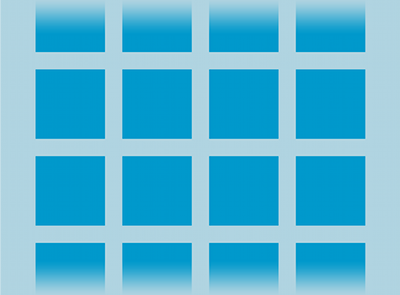GridView is a ViewGroup that displays items in a
two-dimensional,
scrollable grid. The grid items are automatically inserted to the layout using a ListAdapter.
For an introduction to how you can dynamically insert views using an adapter, read Building Layouts with an Adapter.

Example
In this tutorial, you'll create a grid of image thumbnails. When an item is selected, a toast message will display the position of the image.
- Start a new project named HelloGridView.
- Find some photos you'd like to use, or download these sample images. Save the image files
into the project's
res/drawable/directory. - Open the
res/layout/main.xmlfile and insert the following:<?xml version="1.0" encoding="utf-8"?> <GridView xmlns:android="http://schemas.android.com/apk/res/android" android:id="@+id/gridview" android:layout_width="match_parent" android:layout_height="match_parent" android:columnWidth="90dp" android:numColumns="auto_fit" android:verticalSpacing="10dp" android:horizontalSpacing="10dp" android:stretchMode="columnWidth" android:gravity="center" />This
GridViewwill fill the entire screen. The attributes are rather self explanatory. For more information about valid attributes, see theGridViewreference. - Open
HelloGridView.javaand insert the following code for theonCreate()method:public void onCreate(Bundle savedInstanceState) { super.onCreate(savedInstanceState); setContentView(R.layout.main); GridView gridview = (GridView) findViewById(R.id.gridview); gridview.setAdapter(new ImageAdapter(this)); gridview.setOnItemClickListener(new OnItemClickListener() { public void onItemClick(AdapterView<?> parent, View v, int position, long id) { Toast.makeText(HelloGridView.this, "" + position, Toast.LENGTH_SHORT).show(); } }); }After the
main.xmllayout is set for the content view, theGridViewis captured from the layout withfindViewById(int). ThesetAdapter()method then sets a custom adapter (ImageAdapter) as the source for all items to be displayed in the grid. TheImageAdapteris created in the next step.To do something when an item in the grid is clicked, the
setOnItemClickListener()method is passed a newAdapterView.OnItemClickListener. This anonymous instance defines theonItemClick()callback method to show aToastthat displays the index position (zero-based) of the selected item (in a real world scenario, the position could be used to get the full sized image for some other task). - Create a new class called
ImageAdapterthat extendsBaseAdapter:public class ImageAdapter extends BaseAdapter { private Context mContext; public ImageAdapter(Context c) { mContext = c; } public int getCount() { return mThumbIds.length; } public Object getItem(int position) { return null; } public long getItemId(int position) { return 0; } // create a new ImageView for each item referenced by the Adapter public View getView(int position, View convertView, ViewGroup parent) { ImageView imageView; if (convertView == null) { // if it's not recycled, initialize some attributes imageView = new ImageView(mContext); imageView.setLayoutParams(new GridView.LayoutParams(85, 85)); imageView.setScaleType(ImageView.ScaleType.CENTER_CROP); imageView.setPadding(8, 8, 8, 8); } else { imageView = (ImageView) convertView; } imageView.setImageResource(mThumbIds[position]); return imageView; } // references to our images private Integer[] mThumbIds = { R.drawable.sample_2, R.drawable.sample_3, R.drawable.sample_4, R.drawable.sample_5, R.drawable.sample_6, R.drawable.sample_7, R.drawable.sample_0, R.drawable.sample_1, R.drawable.sample_2, R.drawable.sample_3, R.drawable.sample_4, R.drawable.sample_5, R.drawable.sample_6, R.drawable.sample_7, R.drawable.sample_0, R.drawable.sample_1, R.drawable.sample_2, R.drawable.sample_3, R.drawable.sample_4, R.drawable.sample_5, R.drawable.sample_6, R.drawable.sample_7 }; }First, this implements some required methods inherited from
BaseAdapter. The constructor andgetCount()are self-explanatory. Normally,getItem(int)should return the actual object at the specified position in the adapter, but it's ignored for this example. Likewise,getItemId(int)should return the row id of the item, but it's not needed here.The first method necessary is
getView(). This method creates a newViewfor each image added to theImageAdapter. When this is called, aViewis passed in, which is normally a recycled object (at least after this has been called once), so there's a check to see if the object is null. If it is null, anImageViewis instantiated and configured with desired properties for the image presentation:setLayoutParams(ViewGroup.LayoutParams)sets the height and width for the View—this ensures that, no matter the size of the drawable, each image is resized and cropped to fit in these dimensions, as appropriate.setScaleType(ImageView.ScaleType)declares that images should be cropped toward the center (if necessary).setPadding(int, int, int, int)defines the padding for all sides. (Note that, if the images have different aspect-ratios, then less padding will cause more cropping of the image if it does not match the dimensions given to the ImageView.)
If the
Viewpassed togetView()is not null, then the localImageViewis initialized with the recycledViewobject.At the end of the
getView()method, thepositioninteger passed into the method is used to select an image from themThumbIdsarray, which is set as the image resource for theImageView.All that's left is to define the
mThumbIdsarray of drawable resources. - Run the application.
Try experimenting with the behaviors of the GridView and ImageView elements by adjusting their properties. For example, instead of using
setLayoutParams(ViewGroup.LayoutParams), try using
setAdjustViewBounds(boolean).